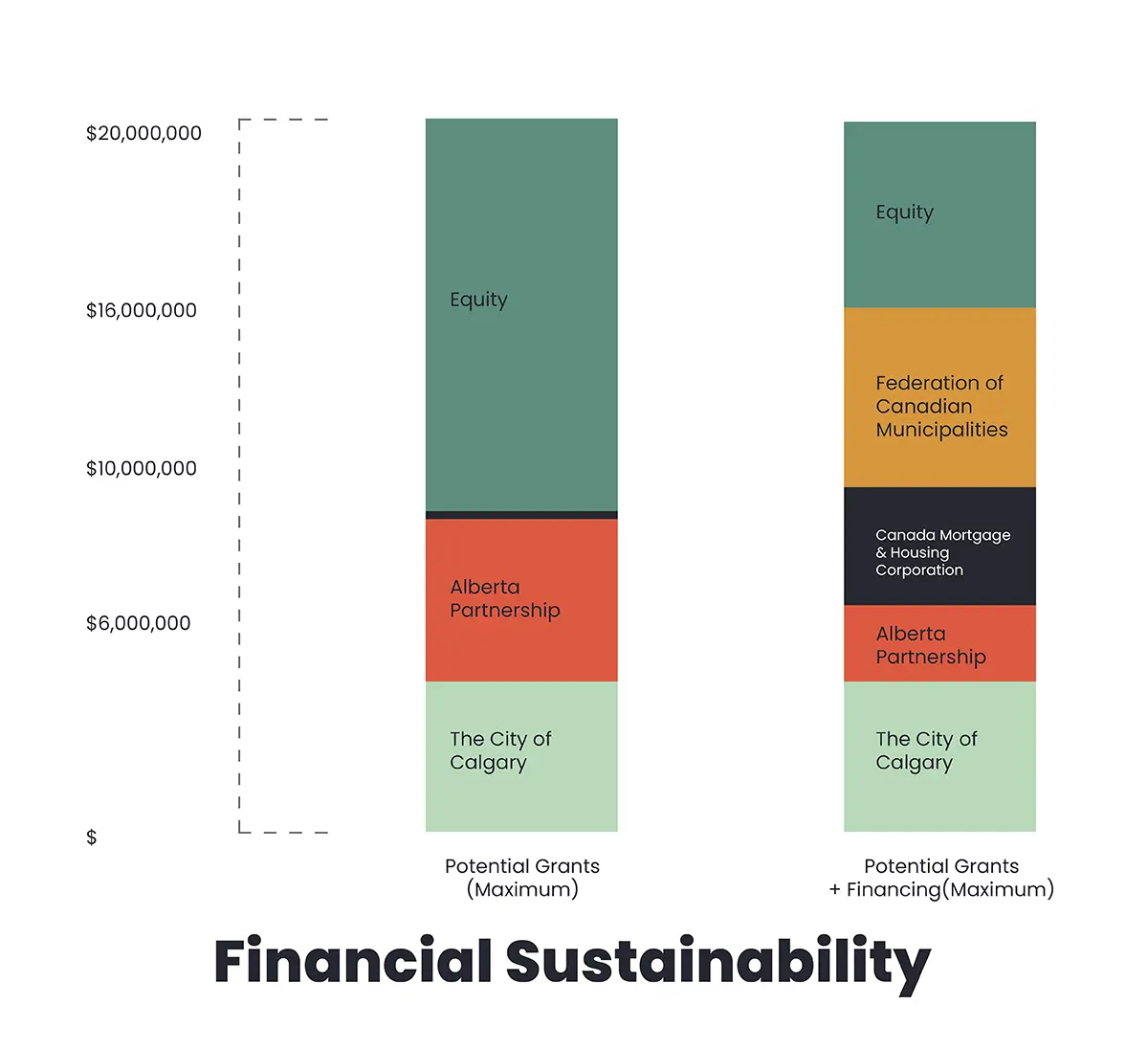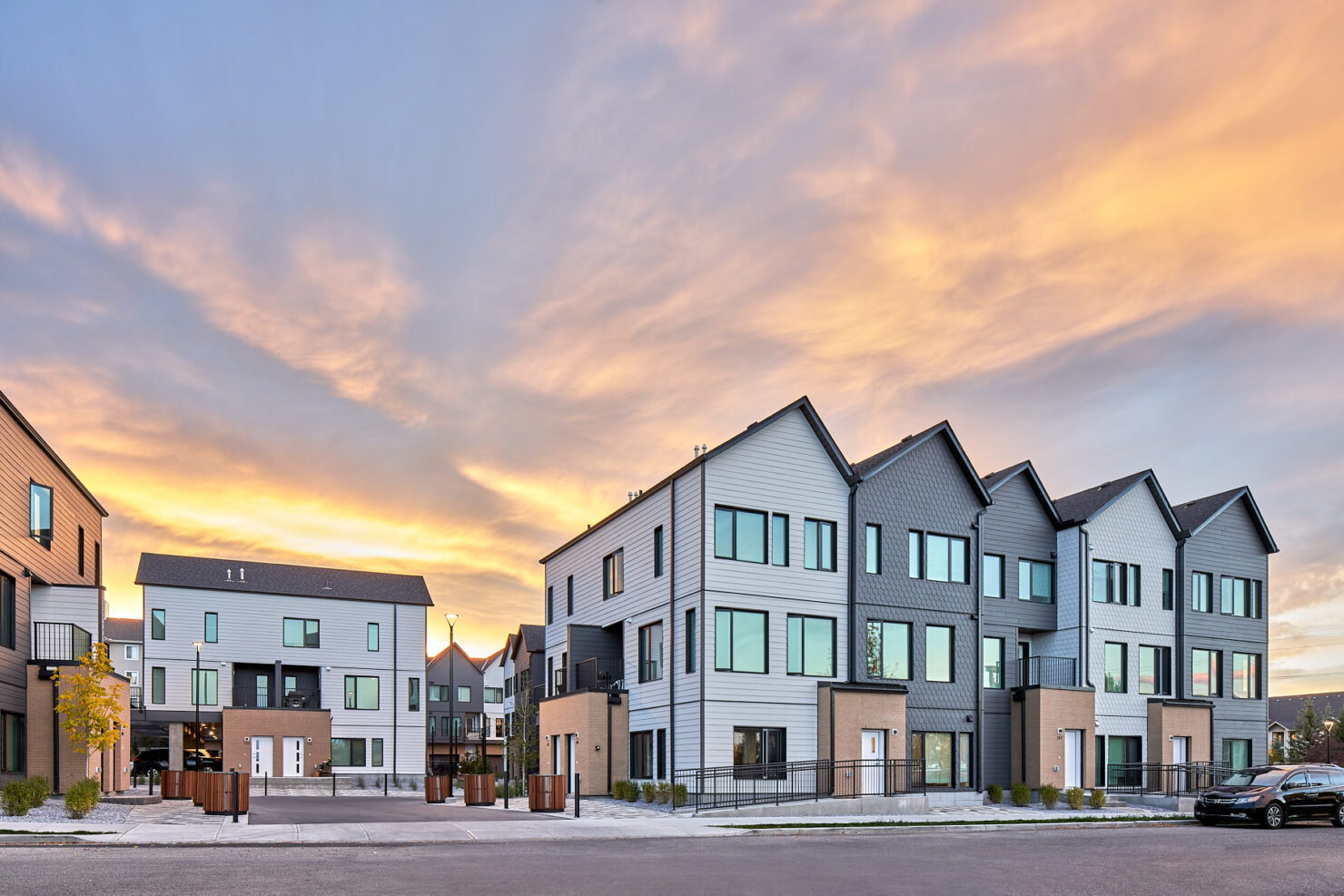Calgary and the Federal Government Join Forces: The Housing Accelerator Fund in support of Calgary’s new Housing Strategy
While details on exactly how the fund will be invested are not yet clearly outlined, what is clear is Calgary’s recently updated Housing Strategy has helped paved the way for federal investments. This Strategy includes over 60 actions, categorized into six overarching goals:
- Making it easier to build housing;
- Making more land available;
- Meeting the needs of equity-deserving populations;
- Facilitating greater collaboration;
- Increasing investment in housing providers; and improving housing security.
The METAFOR Team and Our Friends at Canmore Community Housing Share Strategies for Faster Sustainable Housing at Canmore Symposium

Applying a ‘Sustainability Lens’ to Housing in Helping Build the Stool
We introduce this article with a good news story: a partnership between Federal and local governments with all parties committed to addressing Canada’s housing crisis. Ouelette’s analogy got us thinking deeply about this evolving topic and a reoccurring question from policymakers, investors, and developers: how do these actions, incentives, policies, and investments come together to increase housing stock? What is the common theme that is the proverbial “red thread” that stitches together a patchwork quilt of strategies? The answer becomes apparent when you apply a sustainability lens to the question.
The METAFOR team have been analyzing and supporting our partners and clients in navigating this complex web of programs. We have noticed that social, economic, and environmental sustainability (termed the triple-bottom-line) has emerged as the common language amongst local, provincial, and federal programs aimed at accelerating housing and improving affordability. Understanding how to translate this language into financial strategies that reduce the total cost of ownership can allow project developers to unlock the language necessary to speak to funders, lenders, local authorities, and special interest groups.

The METAFOR Team Delves into Housing Trends – Accessing Capital

Common Sustainability and Resilience Themes in Housing Incentive Programs
Navigating the complex web of local, provincial, and federal programs, all with common goals to accelerate housing developments, can be a challenge for any professional or organization looking to play their part in addressing a quickly growing housing crisis. Beyond the target of bringing new and/or improved housing products to the market, these programs share common goals. These include increasing access to housing to a greater diversity of tenants (accessibility), improved energy and environmental performance (energy efficiency), and most commonly, increased affordability.
The complexity emerges from a lack of a common language and reference guidelines amongst the myriad of performance goals. Even within organizations charged with the task of centralizing financing and funding housing, the definitions for energy efficiency, accessibility, and affordability the diversity are nuanced based on the housing categories targeted. Performance goals and definitions for subsidized rental housing my differ from non-market or mixed market products.
Expert Funding Tip: Identify the Applicable Funding Programs Early in the Project
|
Funding Authority |
The Opportunity |
Affordability Requirement |
Energy Requirement |
Accessibility Requirement |
|
Non-market land sale and potential grant of ≤$75,000 per door |
Average rent of less than 63% of Median Market Rent with a cap on annual household income |
>50% reduction from NECB 2017 |
Full universal design’ with 20% of units accessible. |
|
|
Grant of ≤$85,000 per door |
Mixed rental rate model with a minimum of 10% of units at 60% of Median Market Rent with a cap on annual household income |
N/A |
1 in 10 units must be Adaptable (as per Alberta Building Code) to accommodate Barrier Free access into the future. |
|
|
Combined financing and non-repayable loan of $25,000 - $75,000 per door |
Minimum of 30% of the units must be less than 80% of the Median Market Rent |
Minimum 15% reduction from NECB in energy and emissions |
Options: 20% Accessible or Full Universal Design |
|
|
The Federation of Canadian Municipalities Sustainable Affordable Housing Program |
Combined financing (and non-repayable loan (up to 50%) to a maximum of $10M |
Minimum of 30% of the units must be less than 80% of the Median Market Rent |
The project must be working towards net-zero energy (NZE) or net-zero energy ready (NZER). |
N/A |
Expert Funding Tip – Be transparent in how you determine your baseline when quantifying energy and GHG emissions reductions.
Electricity or Natural Gas? Navigating Electrification Challenges and Regional Disparities in Pursuit of a Sustainable Future
Introducing conservation measures such as electrification is considered a step in the direction toward a zero-carbon future. This is driven by the effectiveness of policy mechanisms such as the coal phase out regulations central to the Harper government’s environmental policies (2012), in generating broad and fast paced reductions in Alberta’s electricity grid GHG emissions intensity (tonnes of carbon emitted per megaWatt-hour of power generated on the integrated electricity system). If you would like to learn more about the sunset on coal power in Alberta, we recommend Jeayakumar and Noels very informative summary (Pembina, March 2023).
Unfortunately, even after a decade of deep reductions in grid emissions intensity, building electrification in Alberta can lead to improvements in terms of energy efficiency (% reduction from the National Energy Code for Buildings (NECB) in terms of kilowatt hours of energy used per square meter of occupied space), while also increasing the greenhouse gas emissions intensity (reported as kg CO2e per m2) of a building. On an energy and scope equivalence basis, the calculated GHG emissions intensity of natural gas (combustion) is approximately 0.2 kg CO2e per kWh-equivalent, whereas Alberta’s grid emission intensity factor is currently estimated at 0.59 kg CO2e per kWh.


What is accessible to one may be a barrier to another – Addressing Canada's Housing Crisis: METAFOR's Innovative Approach to Accessible Housing Design
The key to accessibility considerations in a housing project is that accessibility related design and the implementation of selected are made with good judgement. Decisions should be made utilizing ongoing feedback from lived experiences of those who will occupy the space, with practicality in mind. Accessibility strategies should be created with an awareness of the underlying rationale for the requirements, including flexibility to broad spectrum of needs, adaptability as requirements and tenants change over time, and code compliance.
METAFOR’s team of third-party accessibility consultants help inform us and our clients about their lived experiences in facing accessibility challenges while providing the project the attestations and thoughtful, flexibility focused design specifications required to address the requirements of funding programs. Check out the CMHC’s Guidelines on Universal Design (CMHC, 2023), which have served as a very informative reference in developing practical and effective accessibility-focused design specifications.
Navigating Financial Challenges in Non-Market Housing
Defining affordability: where data and reality are out of sync – We do not envy the challenges faced by non-market housing project developers in the balancing act required to develop a financially feasible project over the long term. Often, in exchange for capital, the non-market housing projects are required to provide deep subsidies to tenants, indexed to the local median-market rent and the median-household income.
These deep subsidies, while needed by those who call these projects home, can generate an imbalance in supporting the long-term financial feasibility of non-market, rental housing projects even when capital (grants and low-cost financing) are secured. We hear your pain. There is no easy solution to this challenge. One strategy to mitigate the challenges of uncertainty that can potentially delay decision-making is to employ a risk-based approach to cost-benefit analysis.

Our recommended approach is to ensure a range of potential costs and revenues are considered. For example, the cost of ownership analysis on a non-market housing project should be run multiple times to address the sensitivity of achieving a net-positive financial return. Consider a range of costs of utilities, operations and maintenance, labour, rent rates and average household incomes. This supports developing alternative scenarios to inform decision-making, including the identification of mitigation measures to address uncertainties.
Ready to tackle the challenges of affordable housing in the midst of Canada's housing crisis?
View Our Projects
Our Projects Are Helping Make Tomorrow Better Than Today by Addressing Alberta's Housing Crisis
Authors
Alison MacLachlan




